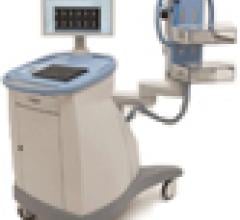If you enjoy this content, please share it with a colleague
Naviscan PET Systems
RELATED CONTENT
August 4, 2011 – Published last week in The American Journal of Roentgenology, researchers from Swedish Cancer Institute and the University of Washington used positron emission mammography (PEM) to find a correlation between fludeoxyglucose (FDG) uptake values and the prognostic factors that predict breast cancer survival. The highest FDG levels were in the most aggressive cancer type – triple negative cancers. Women with triple negative breast cancer have a higher mortality because there is no tailored therapy available to them. PEM may now benefit this patient population as it may help identify when a chemotherapeutic regimen is not working. PEM also has the potential to play a role in initial staging of breast cancer in patients at high risk for multifocal or multicentric disease who desire breast conservation therapy as an alternative to breast MRI.
Despite its first commercial appearance in the late 1970s, positron emission tomograpnhy (PET) did not begin gaining widespread acceptance as a viable clinical technology until the mid-1990s. This was after it gained approval for reimbursement and radiopharmaceuticals for PET became more widely available.
Positron emission mammography (PEM), a high-resolution breast PET scanner, relies on differences in glucose metabolism to identify breast cancers from normal breast cells. Using PEM, we have an opportunity to find cancers at an even earlier stage than that detected with breast MRI, and we may even have the opportunity to find atypia because it changes cellular metabolism prior to the advent of neoangiogenesis. PEM has been shown in recently published prospective data to have similar sensitivity and superior specificity to breast MRI.
May 6, 2011 – Naviscan has entered into a distribution agreement with Tecnologie Avanzate s.r.l. to market and service Naviscan’s high-resolution, organ-specific PET scanner in Italy. The agreement represents the introduction of PEM (Positron Emission Mammography), the scanner’s breast application, as a new tool available to Italian women in their fight against breast cancer.
May 4, 2011 – Researchers from the University of Cincinnati presented results from a prospective study demonstrating how positron emission mammography (PEM)-guided biopsy may expedite pre-operative work-up and reduce radiation exposure for breast cancer patients.
March 3, 2011 – A positron emission mammography (PEM) scanner has been launched at two radiology conferences in Vienna. The Naviscan PEM scanner can reduce unnecessary biopsies by providing superior specificity, and has the ability to differentiate between benign and malignant lesions.
November 15, 2010 — The Radiology journal released new data from an National Institutes of Health (NIH)-sponsored, multisite study of hundreds of women with newly diagnosed breast cancer that shows positron emission mammography (PEM) may reduce unnecessary breast biopsies.
September 29, 2010 — In a prospective study published in the European Journal of Nuclear Medicine and Molecular Imaging, researchers at Boca Raton Regional Hospital, Boca Raton, Fla., showed that positron emission mammography (PEM) and breast magnetic resonance imaging (MRI) had a comparably high ability to detect cancerous lesions.
May 12, 2010 - Positron emission mammography (PEM) may reduce unnecessary breast biopsies, according to new data from an National Institutes of Health (NIH)-sponsored, multisite study of hundreds of women with newly diagnosed breast cancer.
March 17, 2010 - New data from an NIH-sponsored, multi-site study showed the positron emission mammography (PEM) had 31 fewer unnecessary biopsies and 26 percent higher positive predictive value (PPV) than breast MR. Researchers said this may reduce unnecessary breast biopsies.


 August 04, 2011
August 04, 2011 



